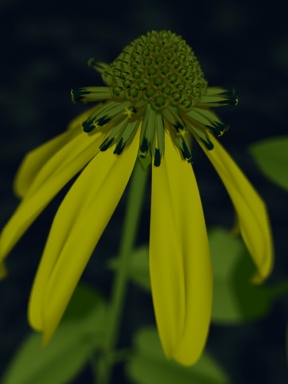 Exogenous control mechanisms may occur not only between
a plant and its environment, but also between components of the same plant.
We will illustrate this phenomenon using a model of spiral phyllotaxis,
or spiral arrangement of organs such as leaves, florets, or seeds. An example
of spiral phyllotaxis is shown in
Plate 36.
Exogenous control mechanisms may occur not only between
a plant and its environment, but also between components of the same plant.
We will illustrate this phenomenon using a model of spiral phyllotaxis,
or spiral arrangement of organs such as leaves, florets, or seeds. An example
of spiral phyllotaxis is shown in
Plate 36.
Many models were proposed to explain the emergence of phyllotactic
patterns in nature. One of them is the collision-based model, introduced
as a biological theory by Battjes [Bat1992],
and subsequently applied to image synthesis by Fowler et al. [Fow1992]. The model describes distribution
of flower initials, or primordia, on a supporting surface, the
receptacle, which determines the shape of the entire structure.
Animation 31
illustrates the operation of
this model. The first primordia (shown as yellow half-spheres) differentiate
at the base of the receptacle (white). The angle between two consecutively
placed primordia, seen from the axis of the receptacle, is equal to 137.5
degrees. The collision-based model assumes this angle as given, but numerous
other theories propose explanations of its value. After a certain number
of primordia have been placed, a new primordium collides with an existing
one. The new primordium is then displaced towards the apex of the receptacle,
so that the predefined minimum distance to the closest neighbor is reached.
The subsequent primordia are placed at the same level until another collision
occurs. Eventually, the entire surface of the receptacle is covered by primordia.


The green coneflower (Rudbeckia laciniata) shown
in
Plate 37
and the cacti shown in
Plate 38
present sample structures generated using
this model. In both cases, the primordia have been replaced by models of
mature organs.
|